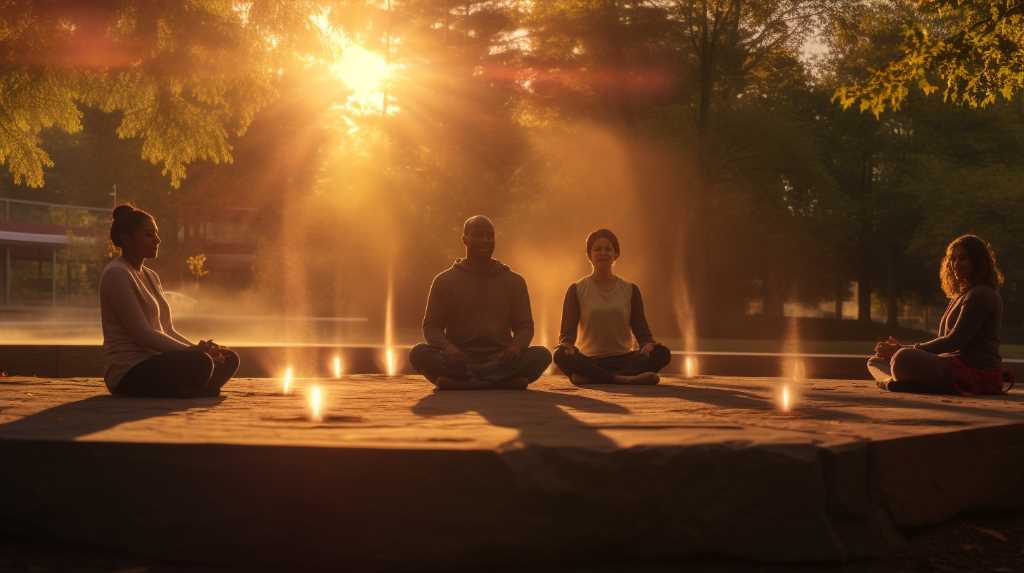Feeling frazzled? Find peace with these five foundational mindfulness techniques. You’re just starting out, so let’s keep it simple.
- Breathe deeply
- Become aware of your body
- Engage your senses
- Observe your thoughts
- Embrace walking meditations
As a newbie, you’ll learn to cultivate calm and sharpen your focus. These practices are your stepping stones to serenity.
So, take a deep breath and prepare to embark on a tranquil journey to inner tranquility.
Key Takeaways
- Breathe deeply to anchor attention and cultivate a sense of calm and clarity
- Utilize breath awareness to notice the rhythm of inhalations and exhalations
- Use a body scan to relax each part of your body and release muscle tension
- Regularly incorporate senses into meditation to sharpen awareness and deepen the experience
Focusing on the Breath
Breath awareness, a cornerstone of mindfulness meditation, allows you to anchor your attention and ground yourself in the present moment. It’s natural to feel a bit adrift when you first begin this practice, but don’t worry. You’re taking the first steps towards cultivating a sense of calm and clarity.
Start by finding a quiet space where you can sit comfortably without interruptions. Close your eyes gently and turn your focus to your breath. Notice the rhythm of your inhalations and exhalations. Feel your chest rise and fall. This simple act of observation is your path to stillness.
If your mind starts to wander, you might find deep counting helpful. Inhale deeply, and as you exhale, count to one. On the next breath, count to two. Continue this pattern up to five, then begin again. This method helps to maintain your focus and brings you back to the breath when distractions arise.
Alternatively, mantra repetition can be a powerful tool. As you breathe in and out, internally repeat a calming word or phrase. This mantra becomes a signal to your mind and body to relax and stay present.
Body Scan Relaxation
You’ll discover that a body scan is an effective technique to relax each part of your body and bring awareness to the physical sensations you often overlook. By tuning into your body, you’ll identify and release the muscle tension that accumulates without your conscious knowledge.
Begin by finding a quiet space where you won’t be disturbed. Lie down or sit comfortably, and close your eyes. Take a few deep breaths to center yourself. Then, slowly direct your attention to the top of your head, and progressively move down to your toes, noting any tension or discomfort without judgment.
Here’s a simple table to guide your body scan:
| Body Part | Focus | Relaxation Cue |
|---|---|---|
| Head & Neck | Notice the weight of your head, any tension in your neck. | Envision the tension melting away. |
| Shoulders & Arms | Feel the sensations in your shoulders, down to your fingertips. | Imagine a wave of relaxation flowing down your arms. |
| Chest & Back | Be aware of your breath here, the rise and fall. | Breathe out tension, breathe in calmness. |
| Legs & Feet | Observe any heaviness or restlessness in your legs and feet. | Allow a sense of warmth to relax your legs completely. |
This practice, often referred to as progressive relaxation, will help you become more attuned to your body’s needs and rhythms. As you finish your body scan, gently bring your attention back to the room, feeling more grounded and calm.
Now, let’s transition into the next step: engaging the senses, which will further enhance your mindfulness journey.
Engaging the Senses
Regularly incorporating your senses into meditation sharpens your awareness and deepens the experience. Sensory grounding is a powerful way to anchor yourself in the present moment. By focusing on what you can see, touch, hear, smell, and taste, you create a full-bodied meditation that can be truly transformative.
Here are four simple techniques to engage your senses:
- Sight: Close your eyes and imagine a place that brings you peace. Visualize the colors, shapes, and textures in vivid detail.
- Touch: Hold a smooth stone or a soft piece of fabric. Concentrate on the sensations against your fingertips.
- Hearing: Listen to the gentle rhythm of your breath or the subtle sounds in your environment, letting them ground you in the here and now.
- Smell: Integrate aroma therapy by lighting a scented candle or using essential oils that relax or invigorate your senses.
As you allow your senses to become heightened, you’ll notice a sense of calm enveloping your body. You’re learning to appreciate the present with a newfound clarity.
Now, let’s gently transition into the next stage of your meditation journey: observing thoughts.
Observing Thoughts
As you become more attuned to your senses, it’s time to turn your attention inward and observe your thoughts without judgment. This practice, known as thought labeling, is a gentle way to recognize and categorize your mental activity.
Imagine sitting by a stream where your thoughts are leaves floating by. As each leaf drifts into your view, label it: ‘planning,’ ‘worrying,’ ‘daydreaming,’ and then let it go, returning to your breath or another anchor.
It’s essential to approach this process with non judgmental awareness. You’re not critiquing or engaging with your thoughts; you’re simply acknowledging their presence. Think of yourself as a kind observer, someone who notices but doesn’t interfere. This detachment isn’t about being uncaring or unfeeling; it’s about understanding that thoughts are transient and don’t define you.
When you find yourself getting tangled in your thoughts, draw your focus back to your breath. It’s natural for your mind to wander; don’t scold yourself. Each return to your breath is a victory, a moment of clarity amidst the ebb and flow of your inner life.
With patience and practice, you’ll find peace in this space of observation, where thoughts come and go like waves upon the shore of your mindful presence.
Walking Meditation
While you’re mastering the art of observing your thoughts, consider integrating walking meditation into your practice, a method that grounds mindfulness in bodily movement. Unlike seated meditation, walking meditation involves engaging with the environment while maintaining a reflective state of mind. You’ll find it especially enriching during nature strolls, where the serenity of your surroundings can enhance your mindfulness journey.
Here’s how to begin:
- Choose a Tranquil Setting: Find a peaceful path, ideally in nature, where you can walk without distraction. The calm environment will help you focus and enjoy the experience.
- Start With Intention: Stand still for a moment, take a few deep breaths, and set the intention for your walking meditation. This centers your mind before you start moving.
- Match Your Breath to Your Steps: As you walk, try to sync your breathing with your rhythmic pacing. Inhale over a few steps, then exhale over the next few, forming a pattern that feels natural to you.
- Engage Your Senses: Pay close attention to the sensations you feel – the ground beneath your feet, the air on your skin, and the sounds around you. This sensory engagement brings you into the present moment.
Can Mindfulness Techniques for Meditation Newbies be Used in Conjunction with Meditation Apps for Effective Practice?
Yes, mindfulness techniques for meditation newbies can certainly be used in conjunction with the best meditation apps for practice. These apps often offer guided meditation sessions that can help beginners focus and relax, making the practice more effective. Combining mindfulness techniques with these apps can enhance the overall meditation experience.
Final Thoughts
As you embark on this tranquil journey of self-discovery, remember that 80% of beginning meditators find focusing on the breath the most accessible technique. Let the rhythm of your inhalations and exhalations guide you towards inner peace.
Embrace these mindfulness practices gently; they’re stepping stones to a serene mind and a centered life. Be patient with yourself, as every breath is a new opportunity for growth and calm.
Welcome to the path of mindfulness.




